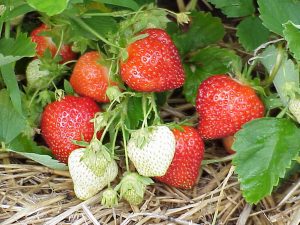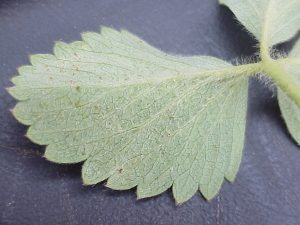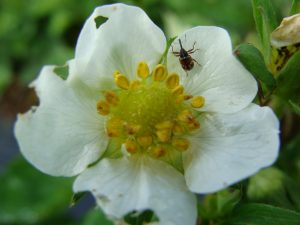Strawberry IPM Newsletter No. 2 – May 26, 2017
 Strawberry IPM Newsletter No. 2 – May 26, 2017
Strawberry IPM Newsletter No. 2 – May 26, 2017
Click on photos to enlarge.
SLOW GROWTH IN THE STRAWBERRY FIELDS
Mites, Clipper Activity Increasing
Berry Growers Twilight Meeting
Tuesday, June 13, 2017 at 5:30 p.m.
Lavigne’s Farm in Sanford, Maine
Situation:
Cool, wet weather predominates, slowing strawberry development. Early fields in southern Maine are coming into bloom, with flower buds just starting to emerge in later varieties. Many growers have applied their first fungicide application for gray mold. Once spray materials have dried on the plants, they are generally considered “rainfast”, unless there is more than one inch of rainfall. At that point, it should be assumed a significant portion of the spray has been washed off, and another application will be needed to assure adequate protection.
Twilight Meeting Tuesday June 13, Lavigne’s Strawberry Farm, 158 Whichers Mill Road, Sanford, ME 04073. Albert and Patrick Lavigne’s farm features large strawberry and high bush blueberry plantings grown on very sandy soil. They have pursued extensive pond construction and irrigation development at the site and have adapted farm equipment to better suit their crops and growing practices. We’ll have a tour of the berry fields and pond construction, and discuss the challenges of water and nutrient management in these very light soils. We will also get an update on the berry pest situation around the state, and have an opportunity to look over the equipment they use and have adapted for their operation. The meeting will run from 5:30 p.m. to 7:30 p.m. We anticipate that two pesticide applicator recertification credits will be awarded for the meeting. Hold the date!
2017-2018 New England Small Fruit Management Guides are Here! Copies are available at Highmoor Farm. The guide contains the latest information on management options for small fruit pests as well as cultural information. Cost of the guide is $12.00 plus $2.63 postage for a total of $14.63.
To order the guides, please send your check made payable to UMaine Cooperative Extension mailed to: Highmoor Farm, P.O. Box 179, Monmouth, Maine 04259, attention Pam St. Peter. For more information, contact Pam St. Peter at 207.933.2100 or pamela.stpeter@maine.edu.
Members of the Maine Vegetable & Small Fruit Growers Association (MVSFGA) or the New England Vegetable & Berry Growers Association will receive free copies of the guide. For MVSFGA membership information, contact Bill Jordan at 207.799.1040.
Strawberry bud weevil or “clipper” activity has been low in most we’ve scouted this week. Only one field in Dresden was over the threshold of more than 1.2 clipped buds per two feet of row. We are seeing the small holes in the petals of opening flowers which indicate clipper feeding activity in many fields, but the females apparently are just starting to lay eggs and clip buds. We expect clipper damage to become more prevalent as temperatures warm and later varieties start coming into bloom. You should start scouting your fields for clipped buds now. Insecticide options for clipper include Lorsban®, Brigade®, Bifenture®, Danitol®, Sevin® and PyGanic®.
- Clipper on Strawberry; photo by David Handley
Tarnished plant bug activity has been low so far, this season. We have seen adults in some fields, but so far have only found one nymph, so no sprays have been recommended. The nymphs can be hard to find, especially if the plants are wet. Young nymphs are very small (2 mm), active, yellow-green insects. It is important to scout for them regularly, as they can appear very quickly. The threshold for nymphs is 4 or more flower clusters infested per 30 sampled. Start scouting any field with open flowers now. Insecticide options for tarnished plant bug include malathion, Assail®, Brigade®, Bifenture®, Dibrom®, Danitol®, and PyGanic®.

Two-spotted spider mites have been found in about half of the fields we scouted this week, and were over threshold in two fields. Although mites typically proliferate under hot, dry conditions, any plantings that harbored a high mite population last fall, which was hot and dry, are likely to see a problem with mites this spring. It is important to scout for mites regularly. If 25% of leaves sampled (e.g. 15 out of 60) have any mites, a spray should be applied. Chemical control options for two-spotted spider mites include Acramite®, Savey®, Zeal®, Portal®, Vendex®, Oberon®, Brigade®, Danitol®, and JMS Stylet oil® (oils will cause plant injury if used in combination with captan or within 14 days of an application of sulfur). Be sure to use enough liquid and pressure in the spray to get good coverage on the undersides of the leaves.
Cyclamen mites: We found one field with light symptoms of cyclamen mite injury this week. Infested plants show weak growth and shrunken, crinkled leaves. These mites are very small and reside in the crown of the strawberry plant, feeding on the developing leaves and flower buds. They are very hard to see, even with magnification. Portal® can be effective, but must be applied in lots of water to be sure that the material is carried down into the crowns where these mites reside.
Diseases: As the fields come into bloom it is important to protect the flowers against infection by spores of the gray mold fungus, Botrytis cinerea. Most fruit infections take place through the flowers, so control efforts should be focused on the bloom period. Two to three sprays of fungicide are typically required to provide good protection. The first spray is usually applied at 5-10% bloom, followed by a second application at petal fall. Additional applications may be applied if there is significant rainfall between or following these two sprays.
Leather rot (Phytopthora cactorum) may become a problem in fields where standing water is common during bloom and fruit development, especially if the fields were not mulched last fall. Incidence of leather rot can be reduced by applying straw mulch between the rows to prevent berries from touching the soil and reducing soil splashing onto the berries. Foliar sprays of Aliette®, Prophyt® or Phostrol® may be applied during bloom and fruit development to prevent leather rot when there has been excess moisture in a field, especially those with a history of this problem.
Powdery mildew: We have seen early symptoms of this fungus disease in a few fields. It will become more prevalent when warmer weather arrives. It may first appear as purple or red blotches on the leaf and flower stems. Later, upward curling leaves and white, powdery growth on the undersides of the leaves becomes evident. Check your fields for pinkish purple leaf and flower stem lesions as new leaves emerge. Pristine®, Cabrio®, Topsin-M®, captan, Procure®, Torino® and JMS Stylet oil® are registered to control powdery mildew.
Leaf spot is a fungal disease characterized by small purple spots with white centers on the leaves. The symptoms are often first visible on the older, lower leaves but often spread throughout the foliage. Spots or lesions may also appear on the leaf and flower stems. The fungus overwinters on older leaves and spreads with rain splashing in the spring. Severe infections can weaken plants, reducing fruit size, yield, and winter survival. We have seen lots of leaf spot in fields this spring. Varieties vary quite a bit in susceptibility to this disease. If you see leaf spot in your field, you should consider using a fungicide that will provide control as part of your spray program for gray mold. Products such as Captan®, Luna Sensation®, Mervion® and Pristine® have activity on both diseases.
Sincerely,
David T. Handley
Vegetable and Small Fruit Specialist
Highmoor Farm, P.O. Box 179, 52 US Route 202, Monmouth, ME 04259, 207.933.2100
UMaine Extension Diagnostic Research Lab, Pest Management Unit, 17 Godfrey Drive, Orono, ME 04473, 1.800.287.0279
Where brand names or company names are used it is for the reader’s information. No endorsement is implied nor is any discrimination intended against other products with similar ingredients. Always consult product labels for rates, application instructions and safety precautions. Users of these products assume all associated risks.
The University of Maine is an equal opportunity/affirmative action institution.

